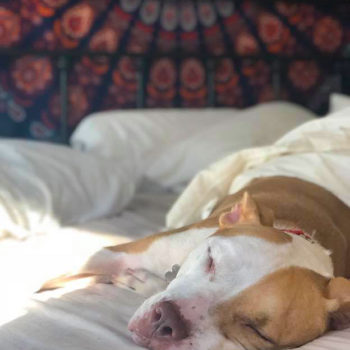When two large incoming pet transports occurred at the same time as a planned move into a new facility, Barbara Hutcherson and her team from Lost Dog and Cat Rescue Foundation almost didn’t make it to Maddie’s® Field Trip and Sleepover Foster Apprenticeship at the Charlottesville-Albemarle SPCA. They’re glad they did: here, they were given the tools to create an emergency foster program which allowed them to get dozens of dogs out of the facility and into foster care virtually overnight.
“When we teach about these situations during apprenticeships, just about every student can relate personally to a situation where space was an issue,” said Lindsey Huffman, Program Manager at the Charlottesville-Albemarle SPCA. “Emergency foster pleas are a tool that almost every single one of us in animal welfare will need to use at some point in our lives.”
On the second day of the 3-day apprenticeship, emergency foster programs were presented. “Because we were at the apprenticeship together, we were extra motivated and empowered to make something big happen,” said Hutcherson. “We also had ideas for tools and strategies, thanks to what we were learning.”
The team flew into action immediately. They modified their existing foster program to add an emergency component and posted their first plea before the end of the day. By the end of the apprenticeship’s third and final day, the group had dozens of foster applications in their inbox.
Ultimately, they received 61 applications and sent 25 dogs to foster care during the initiative, allowing the organization to free up space and taking strain off their staff. Many applicants who didn’t foster initially ended up fostering at a later date.
Here’s how they did it:
They used emojis to frame their plea. This helped their urgent request stand out on social media. Research shows that Facebook posts incorporating emojis receive 57% more likes, 33% more comments and 33% more shares. On Instagram, posts containing at least one emoji receive 47.7% more interactions.
They were clear about what they needed and why. This helped paint a picture in their supporters’ minds of what the problem was and why they needed help, creating an emotional connection between the pets and their supporters. They asked supporters to share their plea far and wide, which helped to include everyone whether they could foster or not.
They gave potential fosters options for timing. The shorter the required time period, the more people would be able to help. The team asked for foster caregivers for 1 week, but allowed fosters to keep their dogs for longer or until adoption if they preferred.
And prefer, they did! “Out of the 25 who went to foster as a result of that urgent plea,” Hutcherson tells us, “Only 4 came back at the end of the week. The others were adopted or remained in foster until adoption. Two dogs were adopted by their fosters.”
They made it as easy as possible to sign up. “We found using a short Google form made it very easy to manage,” says Hutcherson. “We collected the basic information we needed through the form, assigned foster dogs based on that information and scheduled pickups on the same spreadsheet.”
They called in reinforcements. At pickup time, volunteers were on-hand to answer questions and gather supplies for fosters. The need for assistance varied. Some foster caregivers needed very little time, while others required one-on-one guidance for half an hour or more. Assistance from volunteers made it possible to give everyone the support they needed.
They posted updates. Afterward, they kept the momentum going by posting updates of dogs leaving the building, dogs comfy in foster homes and adoptions that happened through fostering. This was a great way to engage with and thank their supporters, who loved being a part of the program from its beginning to its very successful end.
“Being transparent with the community about emergency or crisis situations has not only been successful for the short-term goal of creating more space for animals by utilizing foster homes, but has also established long lasting effects such as growing your foster base,” said Huffman. “I’m always so humbled by how many people want to step in a help with these types of situations. It really is as simple as just asking.”
Now that she’s seen the results, what advice would Hutcherson give to other organizations considering emergency foster? “Go big!” she says. “It’s amazing how much something like this energizes an organization. It reminded us that there are so many people who want to help and who are willing to work. We sometimes forget to reach outside of our immediate circle. New people breathe new life into an organization – invite them in!”

